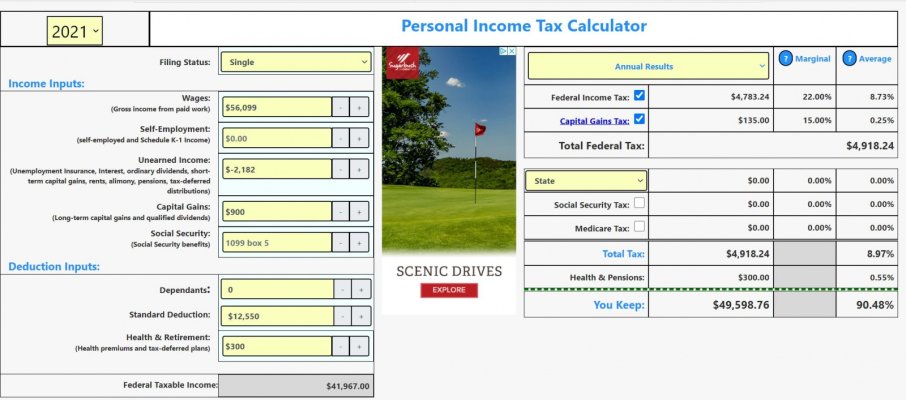jimbohoward69
Recycles dryer sheets
- Joined
- Feb 25, 2007
- Messages
- 70
I was FIRE for over a year but decided to go back to work in April with the Veterans Health Administration...and LOVE IT! 2020 was a good year, tax wise that is, since I was able to harvest a bunch of LTCG w/my limited pension income. The tax math was pretty straight forward then...my pension filled up the 10% bucket and a smidgen of the 12%...leaving quite a bit of room up to the $40K threshold for the 0% LTCG/Qualified dividend rate.
This year will be different, obviously, since my ordinary income will be above the 0% LTCG rate. Here are some specifics (projected of course):
Ordinary Taxable Income (Salary & Pension) - $56,099
S/T Capital Gains - ($2,182) Covered call gone wrong
Qualified Dividends - $900
Charitable Deduction - ($300)
AGI - $54,517
Standard Deduction - ($12,550)
Taxable Income - $41,967
My question stems from where/how to account for S/T CG losses and the qualified dividends. Here's what I came up with:
Ordinary Income @ 10% - $9,950 - $995 taxes
Ordinary Income @ 12% - $30,575 - $3,669 taxes
Ordinary Income @ 22% - $542 - $119 taxes
Qualified Dividends @ 15% - $135 taxes
Total Taxes - $4,918
Just trying to figure out if I need to leave the QD's separate like I did or just figure it all in together. I like doing projections like this so I'm not left owing at the end of the year (can adjust withholding accordingly).
Any advice/feedback would be greatly appreciated...thanks!!
This year will be different, obviously, since my ordinary income will be above the 0% LTCG rate. Here are some specifics (projected of course):
Ordinary Taxable Income (Salary & Pension) - $56,099
S/T Capital Gains - ($2,182) Covered call gone wrong
Qualified Dividends - $900
Charitable Deduction - ($300)
AGI - $54,517
Standard Deduction - ($12,550)
Taxable Income - $41,967
My question stems from where/how to account for S/T CG losses and the qualified dividends. Here's what I came up with:
Ordinary Income @ 10% - $9,950 - $995 taxes
Ordinary Income @ 12% - $30,575 - $3,669 taxes
Ordinary Income @ 22% - $542 - $119 taxes
Qualified Dividends @ 15% - $135 taxes
Total Taxes - $4,918
Just trying to figure out if I need to leave the QD's separate like I did or just figure it all in together. I like doing projections like this so I'm not left owing at the end of the year (can adjust withholding accordingly).
Any advice/feedback would be greatly appreciated...thanks!!

